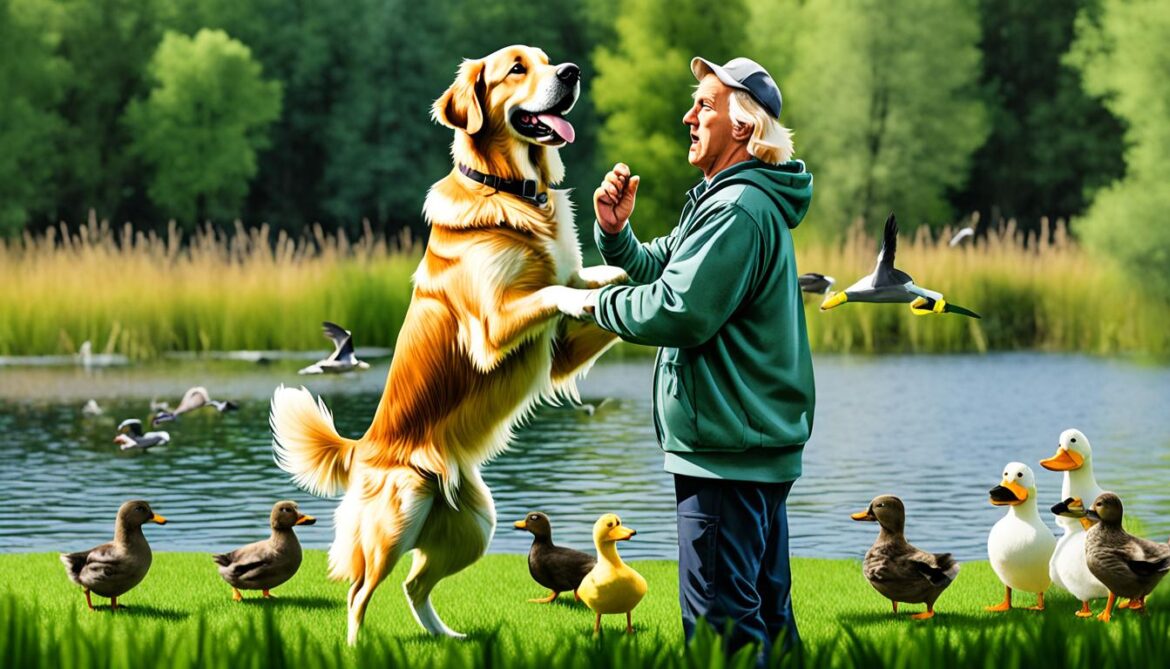Imagine the excitement of watching your retriever effortlessly retrieve a duck from the water or flawlessly execute a command during a dog obedience competition. The bond between you and your retriever is one filled with trust, loyalty, and shared adventures. But to truly unlock your retriever’s full potential, you need to master the art of retriever training.
Whether you’re a first-time retriever owner or a seasoned handler, this comprehensive guide will equip you with valuable tips and techniques to enhance your dog’s obedience and hunting skills. From understanding your retriever’s natural behavior and instincts to teaching essential commands and advanced retrieving techniques, we will cover every aspect of retriever training.
Together, we’ll embark on a journey of transformation, shaping your retriever into a well-trained companion you can be proud of. Get ready to dive into the world of retriever training and unleash your retriever’s full potential!
Key Takeaways:
- Retriever training is crucial for enhancing obedience and hunting skills.
- Understanding your retriever’s behavior and instincts is essential for effective training.
- Teaching essential commands lays the foundation for a well-trained retriever.
- Creating a positive training environment is key to successful retriever training.
- Mastering basic training exercises and advanced techniques empowers your retriever’s skills.
Understanding Retriever Behavior and Instincts
Before diving into the training process, it’s essential to understand your retriever’s behavior and instincts. Retrievers are known for their intelligence, loyalty, and natural instincts, which play a significant role in their learning capabilities. By comprehending these traits, you can tailor your training approach to be more effective.
Retrievers have a strong desire to please their owners, making them highly trainable. Their obedience and willingness to learn make them ideal candidates for a variety of activities, including hunting, search and rescue, and therapy work. However, it’s crucial to recognize that each individual retriever may exhibit unique behaviors and personality traits.
Instincts:
- Retrievers are bred as hunting dogs, and their instinct to retrieve objects is deeply ingrained. This natural drive to fetch and carry objects is an essential foundation for training them in specific tasks or activities.
- They have a keen sense of smell, allowing them to track scents and locate objects or people efficiently. This instinctual ability can be honed for various purposes, such as search and rescue operations.
- Retrievers are often considered water-loving dogs due to their webbed feet and water-resistant coats. Their love for water and natural swimming abilities can be utilized in activities like waterfowl retrieval and dock jumping.
Behavior Modification:
While retrievers are generally well-behaved dogs, they may still exhibit unwanted behaviors that require modification. Common behavioral challenges in retrievers include excessive barking, jumping on people, pulling on the leash, or digging. Understanding the underlying causes of these behaviors is crucial for implementing effective behavior modification techniques.
Retriever Behavior Training:
Behavior training focuses on shaping and modifying a retriever’s actions to ensure they become well-behaved and obedient companions. It involves using positive reinforcement techniques to reinforce desirable behaviors and discourage unwanted ones. By understanding your retriever’s behavior and utilizing targeted training methods, you can overcome behavior challenges and foster a harmonious relationship with your dog.
“A well-trained retriever is a joy to work with, whether in the field or at home.”
| Common Behavior Challenges | Behavior Modification Techniques |
|---|---|
| Excessive barking | Redirect their attention, teach the “quiet” command, and reward calm behavior. |
| Jumping on people | Teach the “off” command, practice impulse control exercises, and reinforce polite greetings. |
| Pulling on the leash | Train loose leash walking, use no-pull harnesses or head collars, and reward walking calmly beside you. |
| Digging | Provide appropriate digging areas, supervise and redirect their behavior, and ensure they receive enough mental and physical stimulation. |
Essential Retriever Training Commands
Building a strong foundation starts with teaching your retriever essential training commands. By mastering these commands, you can ensure that your retriever becomes a well-trained companion, both in obedience and in the field. In this section, we will cover the vital commands that are crucial for effective gun dog training and overall obedience.
1. Sit
One of the fundamental commands is “Sit.” Teaching your retriever to sit on command is essential for maintaining control and discipline. Start by holding a treat above your dog’s head and giving the verbal command “Sit.” Gently press down on the dog’s hindquarters while moving the treat backwards. Once your retriever is in a sitting position, reward them with the treat and praise. Practice this command regularly, gradually reducing the need for treats.
2. Stay
The “Stay” command is crucial for ensuring your retriever’s safety and the success of hunting trips. Begin by having your dog sit, then place your hand in front of their face with the palm facing towards them, while giving the verbal command “Stay.” Take a step back, maintaining eye contact with your retriever. If they stay in position, reward them with a treat and praise. Gradually increase the distance and duration before giving the reward.
3. Heel
“Heel” is an essential command that ensures your retriever walks calmly and obediently by your side. Begin by having your dog sit beside you, then start walking while giving the verbal command “Heel.” Ensure your dog remains close to your side. If they begin to pull or wander, gently correct them by applying slight pressure to their collar or leash. Reward your dog for walking correctly by your side and repeat the process until they understand the command.
4. Come
The “Come” command is vital for calling your retriever back to you, especially in hunting situations or when off-leash. Start by using a long leash and a treat. Gently pull the leash while giving the verbal command “Come.” When your dog reaches you, reward them with the treat and praise. Gradually increase the distance before using the leash, ensuring your retriever reliably responds to the command regardless of distractions.
5. Down
The “Down” command is useful for keeping your retriever calm and under control. Begin by having your dog sit, then lower the treat towards the floor while giving the verbal command “Down.” Guide your dog into a lying position and reward them with the treat and praise. As your retriever becomes more comfortable with the command, gradually reduce the need for treats and practice the command in various environments.
Mastering these essential commands will lay the groundwork for successful retriever training. Practice them consistently and with patience, building a strong bond with your retriever while enjoying the rewarding process of gun dog training.
| Command | Description |
|---|---|
| Sit | Teaches your retriever to sit on command, establishing control and discipline. |
| Stay | Instructs your retriever to remain in a specific position until released, ensuring their safety and effective hunting. |
| Heel | Trains your retriever to walk calmly and obediently by your side without pulling or wandering. |
| Come | Enables you to call your retriever back to you, even in challenging environments or off-leash situations. |
| Down | Teaches your retriever to lie down on command, promoting calmness and control. |
Establishing a Positive Training Environment
Creating a positive training environment is crucial for the success of your retriever training journey. By setting up a conducive learning atmosphere, you can enhance the effectiveness of your training sessions and ensure that your retriever thrives.
Here are some valuable tips to help you establish a positive training environment:
- Choose the right location: Find a quiet, distraction-free area where you can focus solely on training. This could be your backyard, a nearby park, or even an indoor space if the weather doesn’t permit outdoor training sessions.
- Use positive reinforcement: Reward-based training techniques are highly effective in promoting positive behavior. Use treats, praise, and affection to reinforce desired behaviors and motivate your retriever to continue learning.
- Set a consistent routine: Regular training sessions help establish a structured routine that your retriever can adapt to. Aim for short, frequent sessions to maintain your dog’s attention and prevent boredom.
- Provide appropriate training tools: Investing in the right training tools and equipment can aid in your retriever’s learning process. Items such as leashes, clickers, and training dummies can assist you in teaching specific commands and skills.
- Make it enjoyable: Training should be a positive and enjoyable experience for both you and your retriever. Incorporate fun activities, such as retrieving games or agility exercises, to keep your dog engaged and excited to learn.
A positive training environment not only accelerates your retriever’s progress but also strengthens the bond between you and your furry companion. With consistent practice and patience, you’ll witness remarkable improvements in your retriever’s obedience and response to commands.

“Positive training environments create a solid foundation for your retriever’s learning capabilities.”
Basic Training Exercises for Retrievers
In this section, we’ll delve into basic training exercises that will strengthen your retriever’s obedience and responsiveness. By mastering these fundamental skills, your retriever will become a well-trained and reliable companion. From leash training to teaching recall, each exercise plays a crucial role in shaping your retriever’s behavior and ensuring their compliance.
Let’s start with leash training, a fundamental skill that teaches your retriever to walk politely on a leash without pulling or dragging you around. Begin by attaching a leash to your dog’s collar or harness and hold the leash firmly. Remember to use a lightweight and comfortable leash, ideally with a padded handle for added grip.
| Leash Training | Tips |
|---|---|
| Start in a quiet and familiar environment, free from distractions. | Use positive reinforcement techniques such as treats and verbal praise to reward your retriever for walking calmly beside you. |
| Walk in short intervals and gradually increase the duration as your retriever becomes more comfortable on the leash. | Consistency is key. Ensure that you maintain a steady pace and avoid sudden stops or jerky movements. |
| Use verbal cues like “heel” or “walk” to establish expectations and reinforce good behavior. | Avoid pulling or tugging on the leash. Instead, gently redirect your retriever’s attention and reward them for following your lead. |
Next, let’s move on to teaching recall, a vital command that ensures your retriever returns to you promptly when called. Recall training is essential for their safety and your peace of mind, especially during off-leash activities or in emergency situations.
| Recall Training | Tips |
|---|---|
| Choose a quiet and secure area for recall training, preferably with minimal distractions. | Use a confident and upbeat tone when calling your retriever’s name followed by the command “come.” |
| Start by calling your retriever from a short distance and gradually increase the distance over time. | Reward your retriever with praise, treats, or a favorite toy when they respond to the recall command promptly. |
| Avoid scolding your retriever if they don’t come immediately. Instead, continue practicing and reinforcing the command using positive reinforcement techniques. | Make recall training enjoyable by incorporating playful games and rewarding your retriever for their efforts. |
By following these step-by-step instructions and valuable tips, you’ll be well on your way to successfully training your retriever. Remember to be patient, consistent, and always use positive reinforcement techniques to motivate and reward your furry friend.
Advanced Retrieving Techniques
Take your retriever’s skills to the next level with advanced retrieving techniques. Building upon the foundational training covered earlier, these techniques will enhance your hunting dog training and develop your retriever’s abilities in various scenarios. Whether you are targeting waterfowl, upland game, or preparing for field trials, these methods will help optimize your retriever’s performance.
One of the key aspects of advanced retrieving techniques is honing your retriever’s marking abilities. A well-trained retriever should be able to accurately mark the location of fallen game birds or dummies, even at a distance. To achieve this, use exercises that encourage your retriever to maintain focus on the falling objects and develop their memory skills. Gradually increase the distance and difficulty level of the retrieves, challenging your retriever to mark accurately under varying conditions.
Additionally, to enhance your retriever’s hunting instincts, it is important to expose them to realistic hunting scenarios. Set up simulations that mimic hunting situations, such as hiding dummies or scent markers in cover, introducing decoys, or simulating gunshot sounds. Through these exercises, your retriever will become familiar with the sights, sounds, and smells associated with hunting, sharpening their instincts and preparing them for actual fieldwork.
Tips for Advanced Retrieving Techniques:
- Practice marking drills in different terrains (water, fields, dense cover) to improve your retriever’s adaptability.
- Use decoys and scent markers to add realism to training exercises and reinforce hunting instincts.
- Introduce distractions, such as other dogs or noise, to test your retriever’s focus and obedience in hunting situations.
- Continue reinforcing basic training commands to maintain control and ensure your retriever’s safety during retrieves.
Remember, advanced retrieving techniques require patience, consistency, and gradual progression. Adapt the training to your retriever’s individual strengths and weaknesses, and make adjustments as needed. With time and practice, your retriever will develop into a skilled hunting companion, ready to tackle any hunting scenario.

Problem Solving and Behavior Challenges
Every training journey comes with its fair share of challenges. As a retriever owner, you may encounter common behavior issues that require careful attention and effective solutions. By addressing these challenges head-on, you can ensure that your retriever remains well-behaved and responsive to your commands. In this section, we will explore some of the most common behavior problems faced by retriever owners and provide insights into how to overcome them.
Leash Pulling
One of the behavior challenges that many retriever owners face is leash pulling. This can make walks frustrating and tiring for both you and your dog. To address this issue, it’s important to establish proper leash-walking techniques and consistency in training. Here are a few tips to help you curb leash pulling:
- Practice loose leash walking: Teach your retriever to walk beside you without pulling on the leash. Reward them with treats and praise when they walk calmly by your side.
- Use positive reinforcement: Reward your retriever whenever they walk without pulling. Positive reinforcement, such as treats or verbal praise, encourages the desired behavior.
- Be patient and consistent: Leash pulling is a habit that takes time to change. Practice regularly and be consistent in your training to establish a new behavior pattern.
Excessive Barking
Excessive barking can be a nuisance and disrupt the peace in your home. Addressing this behavior challenge requires understanding the root cause of the barking and providing appropriate training techniques. Here’s how you can tackle excessive barking:
- Identify triggers: Pay attention to the situations or stimuli that trigger your retriever’s barking. Understanding the triggers will help you address them effectively.
- Provide mental and physical stimulation: Ensuring that your retriever has enough mental and physical exercise can help prevent excessive barking caused by boredom or pent-up energy.
- Train the “quiet” command: Teach your retriever a command, such as “quiet” or “enough,” to indicate they should stop barking. Reward them when they respond to the command appropriately.
To overcome these and other behavior challenges, consistent retriever behavior modification techniques are essential. Keep in mind that every dog is unique, and it may take time to see improvements. Patience, positive reinforcement, and understanding are key to successfully modifying your retriever’s behavior.
Conclusion
In conclusion, mastering retriever training requires dedication, patience, and the right techniques. By understanding your retriever’s behavior, teaching essential commands, and implementing positive reinforcement, you can foster a well-trained and obedient companion.
Throughout this article, we have provided valuable tips and techniques to help you enhance your dog’s obedience and hunting skills. From understanding retriever behavior to establishing a positive training environment and teaching essential commands, you now have the tools to unlock your retriever’s full potential.
Remember, consistency and positive reinforcement are key in retriever training. The bond between you and your retriever will grow stronger as you navigate through the challenges and successes of the training process. With patience, practice, and a bit of fun, you’ll be amazed at what your retriever can achieve.
So, start implementing the strategies discussed in this article and embark on a rewarding journey of retriever training. Happy training!
